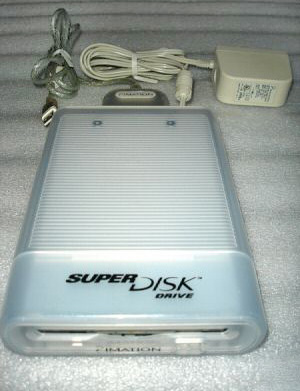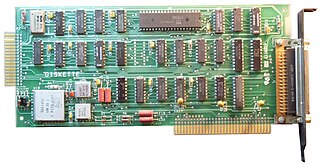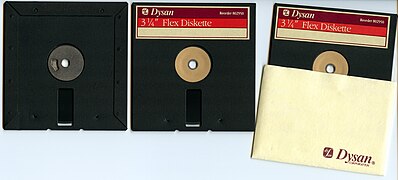
Disk storage is a general category of storage mechanisms where data is recorded by various electronic, magnetic, optical, or mechanical changes to a surface layer of one or more rotating disks. A disk drive is a device implementing such a storage mechanism. Notable types are the hard disk drive (HDD) containing a non-removable disk, the floppy disk drive (FDD) and its removable floppy disk, and various optical disc drives (ODD) and associated optical disc media.

A floppy disk or floppy diskette is a type of disk storage composed of a thin and flexible disk of a magnetic storage medium in a square or nearly square plastic enclosure lined with a fabric that removes dust particles from the spinning disk. Floppy disks store digital data which can be read and written when the disk is inserted into a floppy disk drive (FDD) connected to or inside a computer or other device.

The TRS-80 Micro Computer System is a desktop microcomputer launched in 1977 and sold by Tandy Corporation through their Radio Shack stores. The name is an abbreviation of Tandy Radio Shack, Z80 [microprocessor]. It is one of the earliest mass-produced and mass-marketed retail home computers.

The Osborne 1 is the first commercially successful portable computer, released on April 3, 1981 by Osborne Computer Corporation. It weighs 24.5 lb (11.1 kg), cost US$1,795, and runs the CP/M 2.2 operating system. It is powered from a wall socket, as it has no on-board battery, but it is still classed as a portable device since it can be hand-carried when the keyboard is closed.

The SuperDisk LS-120 is a high-speed, high-capacity alternative to the 90 mm (3.5 in), 1.44 MB floppy disk. The SuperDisk hardware was created by 3M's storage products group Imation in 1997, with manufacturing chiefly by Matsushita.
In computer science, group coded recording or group code recording (GCR) refers to several distinct but related encoding methods for representing data on magnetic media. The first, used in 6250 bpi magnetic tape since 1973, is an error-correcting code combined with a run length limited (RLL) encoding scheme, belonging into the group of modulation codes. The others are different mainframe hard disk as well as floppy disk encoding methods used in some microcomputers until the late 1980s. GCR is a modified form of a NRZI code, but necessarily with a higher transition density.

A USB flash drive is a data storage device that includes flash memory with an integrated USB interface. It is typically removable, rewritable and much smaller than an optical disc. Most weigh less than 30 g (1 oz). Since first appearing on the market in late 2000, as with virtually all other computer memory devices, storage capacities have risen while prices have dropped. As of March 2016, flash drives with anywhere from 8 to 256 gigabytes (GB) were frequently sold, while 512 GB and 1 terabyte (TB) units were less frequent. As of 2018, 2 TB flash drives were the largest available in terms of storage capacity. Some allow up to 100,000 write/erase cycles, depending on the exact type of memory chip used, and are thought to physically last between 10 and 100 years under normal circumstances.

The Macintosh 512K is a personal computer that was designed, manufactured and sold by Apple Computer from September 1984 to April 1986. It is the first update to the original Macintosh 128K. It was virtually identical to the previous Macintosh, differing primarily in the amount of built-in random-access memory. The increased memory turned the Macintosh into a more business-capable computer and gained the ability to run more software. It is the earliest Macintosh model that can be used as an AppleShare server and, with a bridge Mac, communicate with modern devices.

Verbatim is a brand for storage media and flash memory products currently owned by CMC Magnetics Corporation (CMC), a Taiwanese company that is known for optical disc manufacturing. Formerly a subsidiary of Mitsubishi Chemical, the global business and assets of Verbatim were sold to CMC Magnetics in 2019 at an estimated price of $32 million USD.
Micropolis Corporation was a disk drive company located in Chatsworth, California and founded in 1976. Micropolis initially manufactured high capacity hard-sectored 5.25-inch floppy drives and controllers, later manufacturing hard drives using SCSI and ESDI interfaces.

The Rainbow 100 is a microcomputer introduced by Digital Equipment Corporation (DEC) in 1982. This desktop unit had a monitor similar to the VT220 and a dual-CPU box with both 4 MHz Zilog Z80 and 4.81 MHz Intel 8088 CPUs. The Rainbow 100 was a triple-use machine: VT100 mode, 8-bit CP/M mode, and CP/M-86 or MS-DOS mode using the 8088. Although the Rainbow 100 was superior to the IBM PC both technologically and ergonomically, DEC prematurely dropped support of the Rainbow 100 in order to focus on its “bread and butter” minicomputer products instead. Had they maintained the support the machine deserved, they well may have turned Big Blue on its ear. The Rainbow was launched along with the similarly packaged DEC Professional and DECmate II which were also not successful. The failure of DEC to gain a significant foothold in the high-volume PC market would be the beginning of the end of the computer hardware industry in New England, as nearly all computer companies located there were focused on minicomputers for large organizations, from DEC to Data General, Wang, Prime, Computervision, Honeywell, and Symbolics Inc.
Floppy disk format and density refer to the logical and physical layout of data stored on a floppy disk. Since their introduction, there have been many popular and rare floppy disk types, densities, and formats used in computing, leading to much confusion over their differences. In the early 2000s, most floppy disk types and formats became obsolete, leaving the 3+1⁄2-inch disk, using an IBM PC compatible format of 1440 KB, as the only remaining popular format.

A floppy-disk controller (FDC) has evolved from a discrete set of components on one or more circuit boards to a special-purpose integrated circuit or a component thereof. An FDC directs and controls reading from and writing to a computer's floppy disk drive (FDD). The FDC is responsible for reading data presented from the host computer and converting it to the drive's on-disk format using one of a number of encoding schemes, like FM encoding or MFM encoding, and reading those formats and returning it to its original binary values.
A bit nibbler, or nibbler, is a computer software program designed to copy data from a floppy disk one bit at a time. It functions at a very low level directly interacting with the disk drive hardware to override a copy protection scheme that the floppy disk's data may be stored in. In most cases the nibbler software still analyses the data on a byte level, only looking to the bit level when dealing with synchronization marks (syncs), zero-gaps and other sector & track headers. When possible, nibblers will work with the low-level data encoding format used by the disk system, being Group Coded Recording, Frequency Modulation, or Modified Frequency Modulation.

The Toshiba T1000 is a discontinued laptop computer manufactured by the Toshiba Corporation in 1987. It has a similar specification to the IBM PC Convertible, with a 4.77 MHz 80C88 processor, 512 KB of RAM, and a monochrome CGA-compatible LCD. Unlike the Convertible, it includes a standard serial port and parallel port, connectors for an external monitor, and a real-time clock.

Laurence "Larry" Spitters is an American industrialist and investor who co-founded Memorex.
NewDos/80 is a third-party operating system for the Radio Shack TRS-80 line of microcomputers released in 1980. NewDos/80 was developed by Apparat, Inc. of Denver, Colorado. NewDos/80 version 2.0 was released in August 1981. It ran on the TRS-80 Model I and Model III.

A floppy disk is a disk storage medium composed of a disk of thin and flexible magnetic storage medium encased in a rectangular plastic carrier. It is read and written using a floppy disk drive (FDD). Floppy disks were an almost universal data format from the 1970s into the 1990s, used for primary data storage as well as for backup and data transfers between computers.
The MAX-80 is a personal computer released in 1982 by Lobo Systems. It differed from other TRS-80 compatible computers in that it was not hardware compatible with the TRS-80.
The floppy disk is a data storage and transfer medium that was ubiquitous from the mid-1970s well into the 2000s. Besides the 3½-inch and 5¼-inch formats used in IBM PC compatible systems, or the 8-inch format that preceded them, many proprietary floppy disk formats were developed, either using a different disk design or special layout and encoding methods for the data held on the disk.















